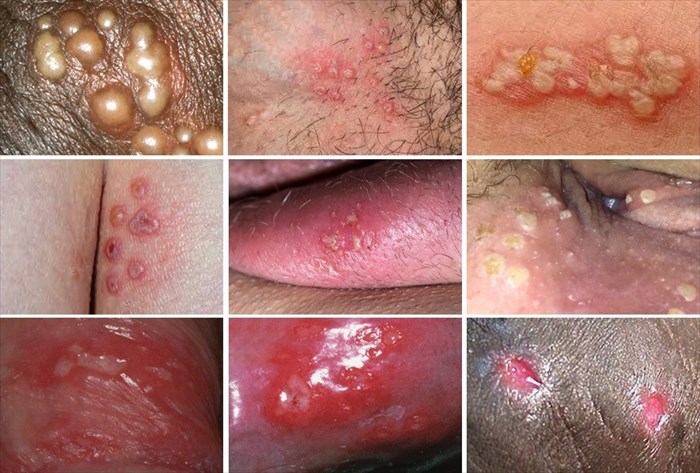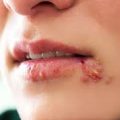What is herpes?
Genital herpes is a sexually transmitted infection (STI) that causes blisters and ulcers. Herpes is caused by the herpes simplex virus (HSV), which is transmitted through skin-to-skin contact. Herpes can affect various areas of the body but is most commonly found on the genitals, anus or mouth. The blisters heal with time (usually within 2-3 weeks), but the virus that causes them cannot be cured, and herpes outbreaks will often reoccur.
How do you get genital herpes?
Herpes is most infectious when you have blisters, but the virus can be passed on even when someone has no symptoms (normally, immediately, straight, before or after an outbreak). Herpes is passed on through skin-to-skin contact, including vaginal, anal or oral sex without a condom or dental dam. This means the virus can be passed on even if you don’t have penetrative sex, orgasm or ejaculate (cum).
Herpes can be passed on by sharing sex toys that aren’t washed or covered with a new condom each time they are used. If you have genital herpes while pregnant, you can pass the virus on to your unborn baby. Speak to your healthcare provider if you’re pregnant and worried you might have herpes.
How do you avoid getting or passing on genital herpes?
If either you or your partner has a herpes outbreak (or if you feel like you might be about to get one), it’s best to wait until the symptoms have cleared up before having sex.
Using a new male or female condom or dental dam every time you have vaginal, anal or oral sex will reduce the risk of herpes being passed on.
Herpes can also be transmitted by sharing sex toys. To reduce your risk, either avoid sharing your sex toys or make sure that they are washed and covered with a new condom between each use.
Use a new dental dam or latex gloves for rimming and fingering (exploring your partner’s anus with your fingers, mouth or tongue) or use latex gloves for fisting, especially if you get herpes on your hands.
Talking about your sexual health with your partners, and letting each other know about any infections that you have, can help you make decisions about safer sex together. Reducing your number of sexual partners can help you reduce your risk of getting sexually transmitted infections, like genital herpes. If you are having sex with multiple partners, it’s even more important to use condoms and to have regular STI checks.
Condoms are the best form of protection against STIs and pregnancy. Other contraceptives including the contraceptive pill will not prevent herpes, and neither will PrEP (pre-exposure prophylaxis).
What do genital herpes symptoms look like?
The most common symptoms of herpes are small blisters that burst to leave red, open sores. You can get herpes blisters on your penis, vagina, anus, throat, on the top of your thighs and buttocks or around your mouth (where they’re called cold sores).
Other symptoms can include:
- pain when urinating (peeing)
- tingling or burning around the genitals
- feeling unwell, with aches, pains and flu-like symptoms
- unusual vaginal discharge in women.
Many people with genital herpes won’t get any symptoms, or may get symptoms for the first time months or even years after they were infected.
For most people, the blisters go away within one to two weeks. Although the outbreaks clear-up by themselves, the virus stays in the body. This means that people usually get blisters again – which is called having a ‘recurrent outbreak’. Outbreaks usually become shorter and less severe over time.
Can I get tested for genital herpes?
Yes, if you think you have symptoms of genital herpes or have been at risk of infection, you should speak to a healthcare worker.
There are different tests available. If you have symptoms, the most common test is to take a swab from a blister. The fluid can be tested for the herpes simplex virus.
Some places may also offer blood tests to check for antibodies to the virus, but these are often not routinely available, so ask a healthcare worker if you’re unsure.
If you have genital herpes you should be tested for other STIs.
It’s also advised that you tell your recent sexual partner/s so they can also get tested and treated. Many people who have genital herpes do not notice anything wrong, and by telling them you can help to stop the virus being passed on.
How is genital herpes treated?
There is no cure for the herpes simplex virus. The blisters usually heal and go by themselves, so you may not always need treatment. There is antiviral medicines for herpes, which can: shorten outbreaks, relieve discomfort and stop symptoms from getting worse.
The antiviral treatment is most effective when you take it within the first five days of symptoms appearing. Avoid touching the blisters as this can also increase the risk of spreading the infection. If your herpes treatment requires you to apply cream to a sore, just gently pat the cream on, being careful not to rub around the surrounding area.
You can ease your symptoms by:
- keeping the affected area clean using plain or salt water to prevent blisters or ulcers from becoming infected
- applying petroleum jelly, such as Vaseline, to any blisters or ulcers to reduce the pain when passing urine
- asking a healthcare provider to recommend painkilling creams
- avoiding tight clothing because it may irritate the blisters and ulcers.
Don’t have sex until you or your partner have finished your treatment, and the blisters or ulcers have gone. If it’s your first outbreak, it’s sometimes advised that you check back with a healthcare provider before having sex again, to ensure that your symptoms have gone.
Genital herpes and pregnancy
It’s really important to speak to a healthcare worker if you have herpes during pregnancy, especially if it’s your first outbreak. There’s a risk that your baby can develop ‘neonatal herpes’ which can be very dangerous or even fatal for the baby. If you have herpes, your healthcare provider will be able to prescribe antiviral treatment to keep your baby safe and help you have a healthy pregnancy.
How Long Does a Herpes Outbreak genital Last?
Most individuals infected with HSV are asymptomatic or have very mild symptoms that go unnoticed or are mistaken for another skin condition. When symptoms do occur, herpes lesions typically appear as one or more vesicles, or small blisters, on or around the genitals, rectum or mouth. The average incubation period for an initial herpes infection is 4 days (range, 2 to 12) after exposure. The vesicles break and leave painful ulcers that may take two to four weeks to heal after the initial herpes infection. Experiencing these symptoms is referred to as having a first herpes “outbreak” or episode.
Clinical manifestations of genital herpes differ between the first and recurrent (i.e., subsequent) outbreaks. The first outbreak of herpes is often associated with a longer duration of herpetic lesions, increased viral shedding (making HSV transmission more likely) and systemic symptoms including fever, body aches, swollen lymph nodes, or headache. Recurrent outbreaks of genital herpes are common, and many patients who recognize recurrences have prodromal symptoms, either localized genital pain, or tingling or shooting pains in the legs, hips or buttocks, which occur hours to days before the eruption of herpetic lesions. Symptoms of recurrent outbreaks are typically shorter in duration and less severe than the first outbreak of genital herpes. Long-term studies have indicated that the number of symptomatic recurrent outbreaks may decrease over time. Recurrences and subclinical shedding are much less frequent for genital HSV-1 infection than for genital HSV-2 infection. In general, how long a herpes outbreak lasts depends on the stage, the several stages genital herpes outbreak and how long they last is presented below:
Stage 1: Prodrome – This stage is highly contagious. Pain, tingling or itching may begin as HSV-2 activates inside the skin.
Stage 2: Skin Redness – The skin may turn red and become sensitive. This lasts 1-4 days.
Stage 3: Lesion Formation – Lesions and sores will begin to appear around the anus or genitals. They will fill with fluid and may become very painful. The sores will last for 2-6 days.
Stage 4: Development of Lesions – This stage is the most contagious. The lesions or sores will continue to grow and eventually burst releasing the buildup of fluid. The sore may stay open and runny for 1-4 days.
Stage 5: Scabbing – After the fluid drains from the sores, they will dry out and scab for a few days.
Stage 6: Healing – The sores heal when the scabs fall off. Sometimes, a scab doesn’t develop, and the sores will just fade away. This process takes about 3-7 days.
How common is genital herpes?
Genital herpes infection is common in many countries. CDC estimates that, annually, 776,000 people in the United States get new genital herpes infections. Nationwide, 11.9 % of persons aged 14 to 49 years have HSV-2 infection (12.1% when adjusted for age). However, the prevalence of genital herpes infection is higher than that because an increasing number of genital herpes infections are caused by HSV-1. Oral HSV-1 infection is typically acquired in childhood; because the prevalence of oral HSV-1 infection has declined in recent decades, people may have become more susceptible to contracting a genital herpes infection from HSV-1.
HSV-2 infection is more common among women than among men; the percentages of those infected during 2015-2016 were 15.9% versus 8.2% respectively, among 14 to 49 year olds. This is possibly because genital infection is more easily transmitted from men to women than from women to men during penile-vaginal sex. HSV-2 infection is more common among non-Hispanic blacks (34.6%) than among non-Hispanic whites (8.1%). A previous analysis found that these disparities, exist even among persons with similar numbers of lifetime sexual partners. Most infected persons may be unaware of their infection; in the United States, an estimated 87.4% of 14 to 49 year olds infected with HSV-2 have never received a clinical diagnosis. SEE: Blue Waffle Disease Pictures






